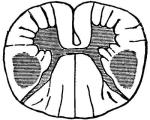Synonyms.—Erb's Palsy; Primary Lateral Sclerosis; Spastic Spinal Paralysis.
Definition.—A chronic disease of the spinal cord, due to sclerosis of the descending fibers of the crossed pyramidal tracts, and characterized by loss of power, contractures, exaggerated reflexes, and a peculiar gait.
Etiology.—The disease generally occurs in neurotic families and between the ages of twenty-five and forty, males being more frequently affected. Sexual excesses, syphilis, exposure, traumatism, and lead-poisoning have been looked upon as causal factors.
 Pathology.—Sclerotic changes are found in the crossed pyramidal tracts. In primary lesions of the brain, the anterior median columns may be involved in the sclerotic process. The axis-cylinders of the nerve-fibers may be destroyed and disappear.
Pathology.—Sclerotic changes are found in the crossed pyramidal tracts. In primary lesions of the brain, the anterior median columns may be involved in the sclerotic process. The axis-cylinders of the nerve-fibers may be destroyed and disappear.
Symptoms.—The disease comes on slowly, the first evidence of any abnormal condition, being an undue weariness on walking, attended by stiffness and rigidity of the muscles. As the disease progresses, it is with difficulty that the patient can walk, the limbs are drawn close together, the knees touch or overlap in walking, the toes drag, and when the patient steps on the ball of the foot, there is clonic spasm of the muscles. As a result of the contractions of the calf-muscles, the body is thrown forward and the patient walks with the crutches or cane thrown in advance of the body.
When the patient is in the recumbent position, clonic spasms may cause the legs to twitch or jerk.
The power of locomotion becomes more difficult with the advance of the disease, and is finally lost.
The knee-jerk is excessive and ankle-clonus is easily obtained. In the advanced stage, if the disease has extended high up the cord, the upper extremities become involved.
Ocular symptoms are rare, and the sphincters are not involved till late in the disease. With the exception of dull pains or fleeting pains in the back, there is an absence of sensory symptoms.
Of the secondary form, the symptoms depend upon the lesion, whether one or both motor tracts are involved, and are bilateral or unilateral. As in the primary form, the symptoms generally appear gradually, there is weakness in the limbs, rigidity of the muscles, and increase of the reflexes, unless the lesion is total, when the reflexes are lost, and there is a flaccid paralysis.
Spastic paraplegia of infants, or congenital spastic paraplegia, is generally due to injury during child-birth, meningeal hemorrhage attending the manipulation of delivery. It may possibly be due, in some cases, to arrested development of the pyramidal tracts. The symptoms are not different from those already described, and may involve the upper as well as the lower extremities.
There may be imbecility, idiocy, or other mental defects.
Hysterical spastic paraplegia simulates the genuine type, though there is not the marked rigidity, especially upon extension. It develops suddenly and there is a history of hysterical attacks.
The Eclectic Practice of Medicine, 1907, was written by Rolla L. Thomas, M. S., M. D.

